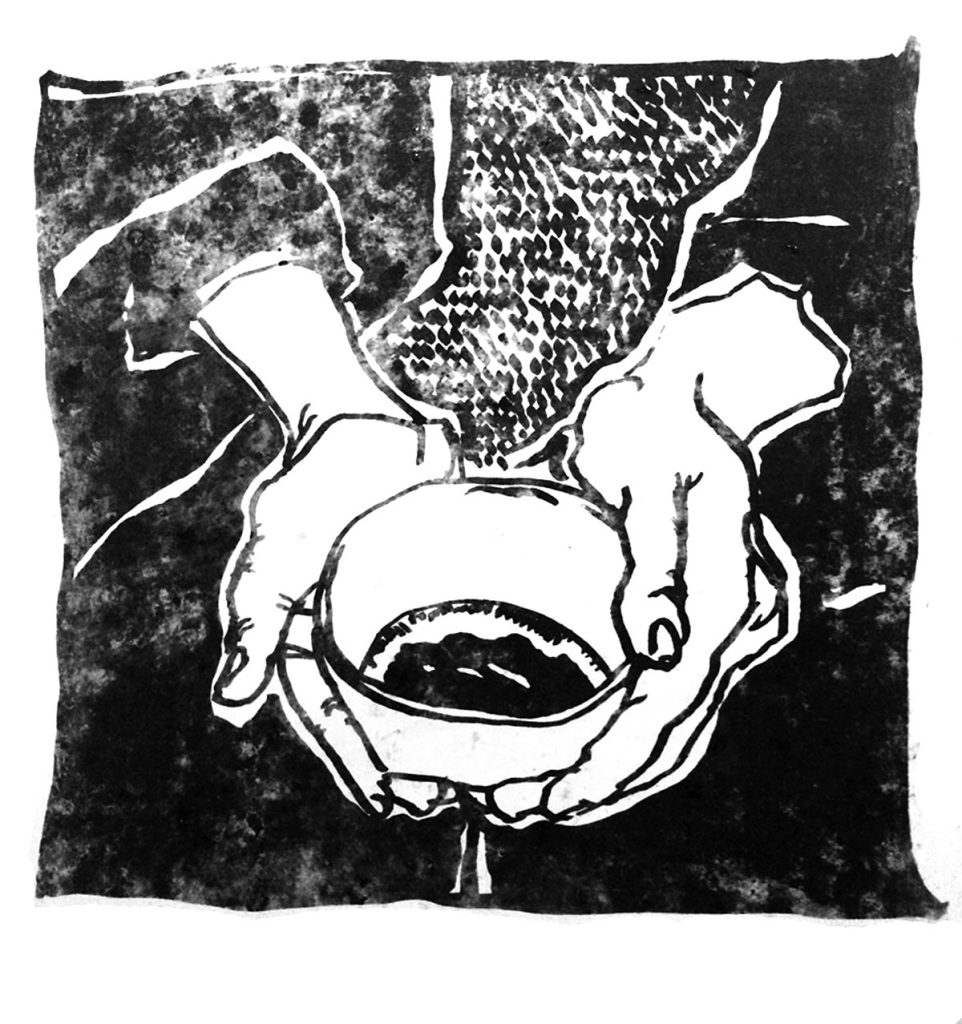After a long winter of rain, the bottomland fields of wild mustard bloom cadmium yellow under a blank cobalt sky. Red-winged blackbirds call from the dank marshland. The brawny root system of mustard penetrates to a depth of six feet, scavenging raw nutrients from wet ground. Above the bog, mustard plants exhale a long sulfurous outbreath into the spring wind.
Mustard carries benefit beyond measure. It is a primary member of the vast Brassicaceae family, also known as Cruciferae for the cross-shaped flower petals of these plants. Thought to have originated in the Himalayan region of India before spreading to Nepal, China, and Japan, the plant has served for five thousand years as food, fiber, medicine, and biological fumigant. It provides a rich source of essential minerals both to the living soil and to humankind; the seeds and leaves of this iconic plant are harvested to help protect against cancer or assist in the treatment of diabetes, to maintain cardiac health and lower blood cholesterol. When ingested, steamed leaves of mustard are known to bind bile in the digestive tract and to stimulate the excretion of fatty acids.
I always associate the fiery taste of mustard with our early years of practice at San Francisco Zen Center in the 1970s. We were still in the thrall of our Asian male teachers in those years and eager to follow their traditional practices. At Tassajara it was not uncommon to serve a Japanese monastic breakfast of brown rice cereal, miso soup, and hijiki seaweed cooked with shaved burdock root and accented with pickled mustard. We often finished our practice day with a medicinal supper of savory gruel and a side bowl of spicy mustard greens, plants with names like Mizuna, Green Wave, Osaka Purple, and Hatakena, chosen from our favorite Kitazawa Seed Co. catalog.
In the tangle of pungent mustard I remember Yaeko Nakamura Sensei, who treasured this wild plant of the Orient, and who taught classic Japanese tea ceremony and Noh theater chanting at Green Gulch for more than 15 years. Zentatsu Richard Baker Roshi, the second abbot of San Francisco Zen Center, encouraged us to study these fundamental Zen arts with her. She was a respected teacher, renewing Zen culture with her refined, discerning, and adamantine practice.
I served as Nakamura Sensei’s tea attendant for many seasons, helping her care for the maintenance of the formal tearoom; she also trusted me to harvest humble flowers from the Green Gulch fields for the tea ceremony. I remember how in springtime after tea class she stepped out of her formal teaching kimono and walked slowly down through the farm fields in her simple work robes to stand in silence before the blaze of mustard, her hands clasped loosely behind her back.
Elegant and aristocratic in her bearing, Nakamura Sensei was never caught by grandeur or fame. She began teaching in North America when she was in her mid-seventies. In an era when very few Asian women were entrusted to convey the authentic Zen arts, Nakamura Sensei carried forward the original lineage of the 16th-century Zen practitioner and tea master Sen no Rikyu. Without hesitation, Sensei trained bumbling and sincere Western practitioners in Rikyu’s tradition of “Wabi Tea,” a reference to wabi sabi, honoring a way of life, a spiritual path, and a starkly intimate aesthetic conveyed by incomplete, imperfect, and impermanent expression.
Almost 30 years ago in March, just after the vernal equinox, I was walking up from the ocean through the bottomland fields of the gulch. It was early afternoon and mustard was in full cry, incandescent in the spring sunlight. I stood in the backwash of the mustard, thinking of Nakamura Sensei, who was older then and no longer able to walk the fields. Impulsively I cut a wide swath of gold mustard flowers for Sensei and staggered to her doorstep, a slow-moving mountain of mustard medicine.
Nakamura Sensei greeted me at the threshold in stunned silence. Without explanation she crumpled to her knees and began to weep uncontrollably. Fortunately, Virginia Baker, who tended Sensei for years, was present and hurried to comfort her and to translate for me what had happened. Apparently I had unknowingly harvested wild mustard on the exact anniversary of Sen no Rikyu’s death by ritual suicide, or seppuku, commanded in 1591 by feudal warlord Toyotomi Hideyoshi. In the Japanese tea world, there is unspoken agreement never to harvest mustard from the time it begins flowering in late winter until after the anniversary of Sen no Rikyu’s death.
Before fulfilling Hideyoshi’s command and raising the “sword of eternity” to end his life, Sen no Rikyu’s last act on earth was to prepare and host an exquisite tea ceremony. After serving tea on that solemn occasion, the master smashed the priceless tea bowl he had used in the ceremony. As the guests departed, Rikyu presented each one with a memorial gift chosen from the ceremonial tea utensils. In the solitude of his rustic tearoom hung a simple scroll with calligraphy evoking the evanescence of all that is. At the base of this scroll Rikyu had arranged a single wild mustard flower.
This season I renew my gratitude to Nakamura Sensei with uncut mustard as my witness. I remember Rikyu’s charge that each meeting of host and guest be a treasured encounter. “One time, one meeting,” he taught, invoking the long mystery of a garden path unfolding through fields of wild mustard far from this fleeting world. “The path remains a way to us,” he promised. “Why not shake off right here the dust from our hearts?”
Thank you for subscribing to Tricycle! As a nonprofit, we depend on readers like you to keep Buddhist teachings and practices widely available.
